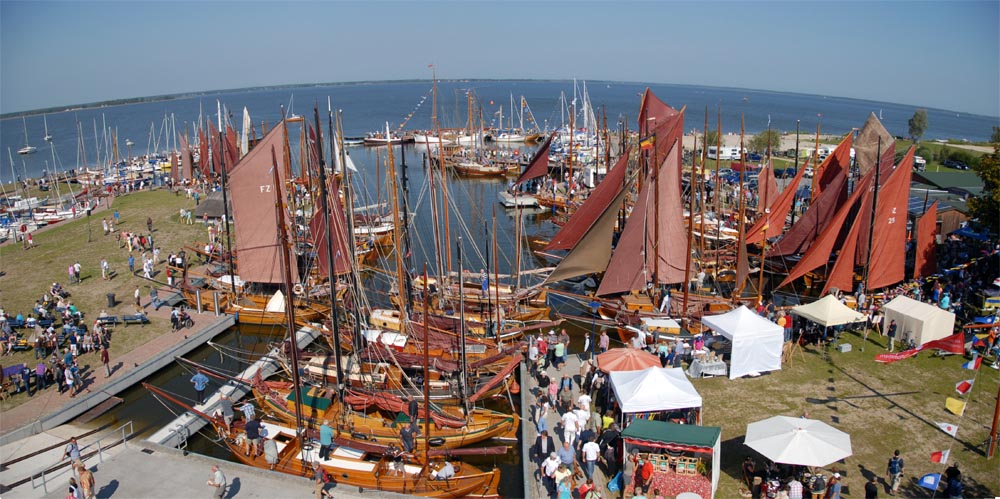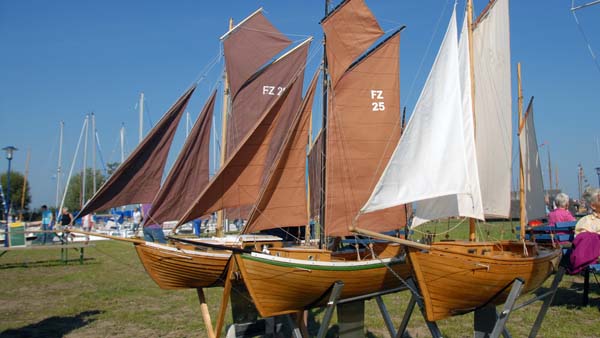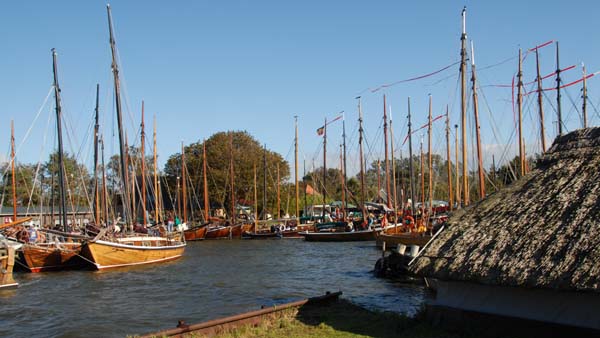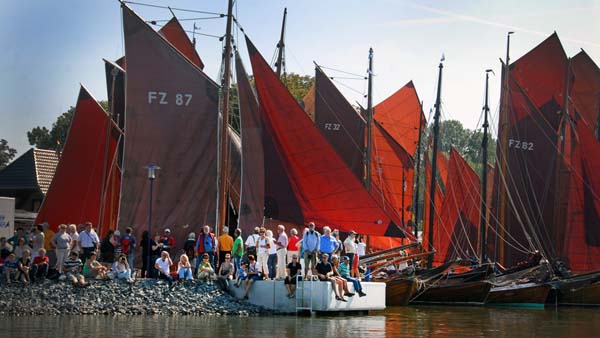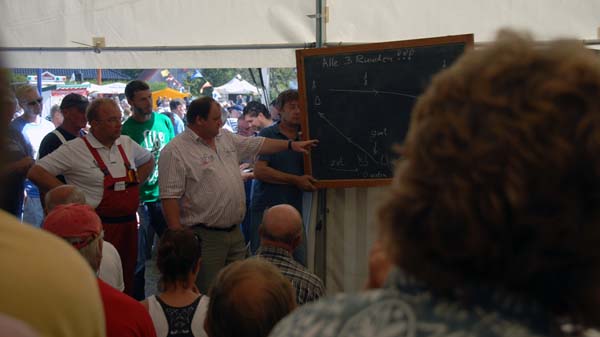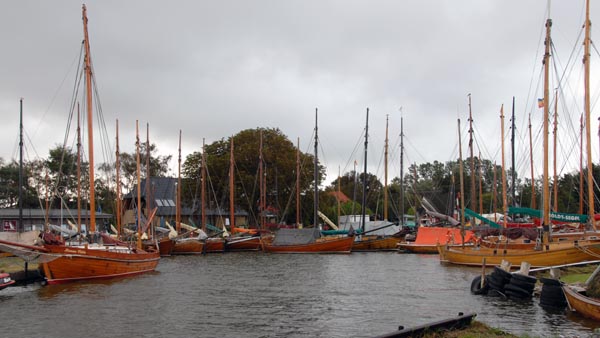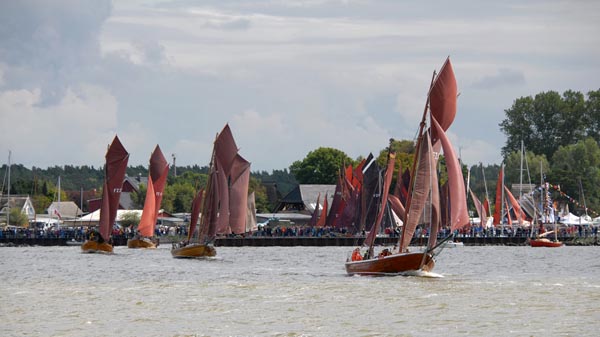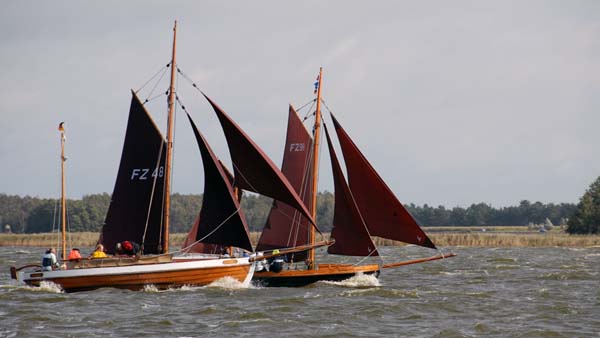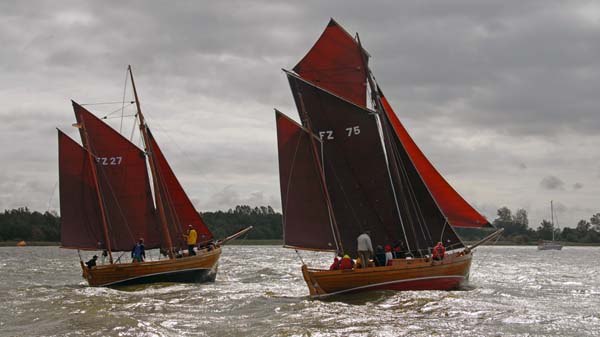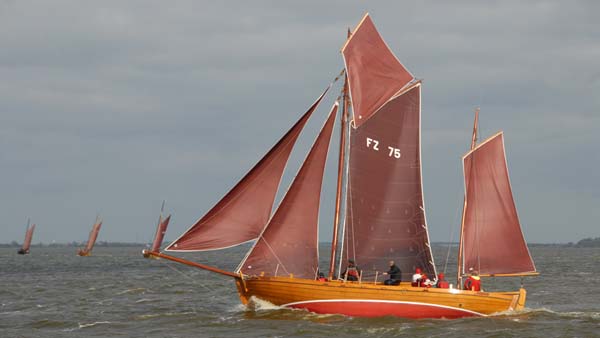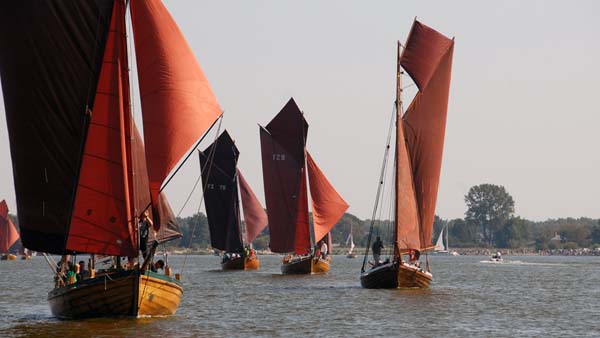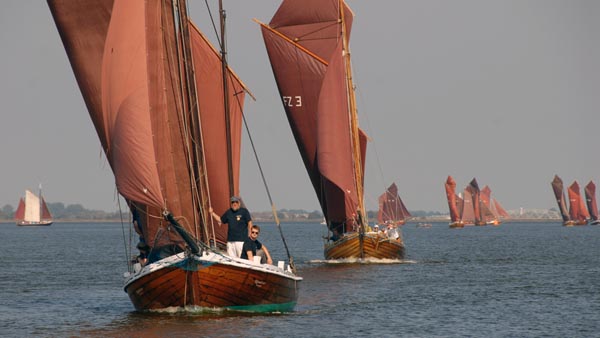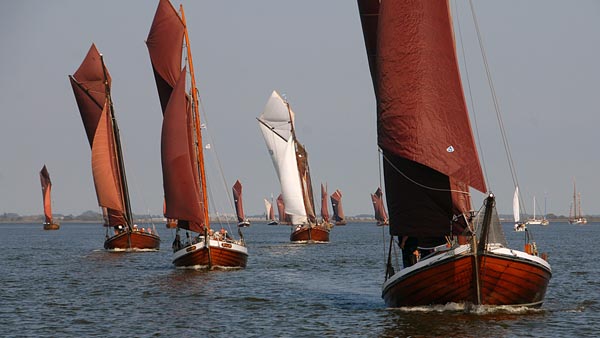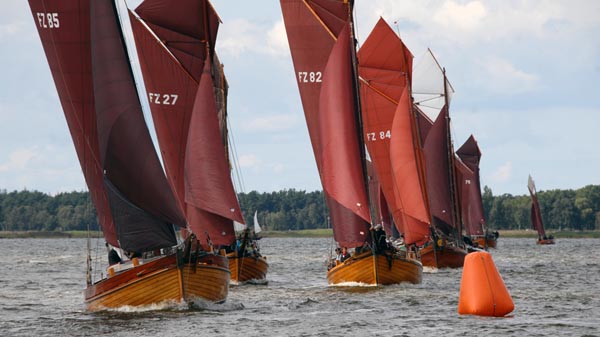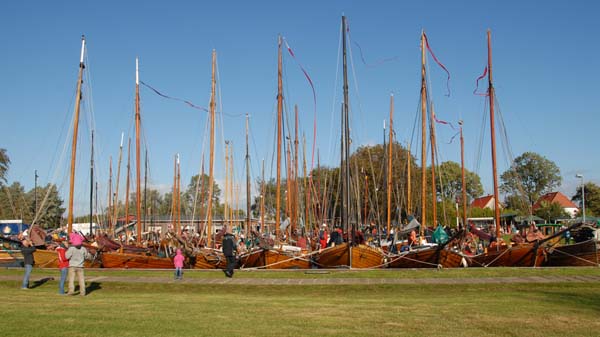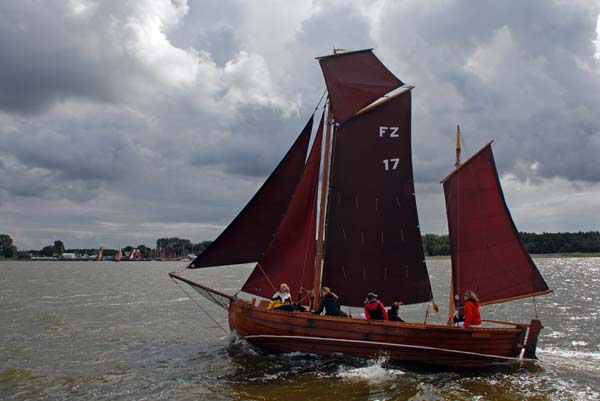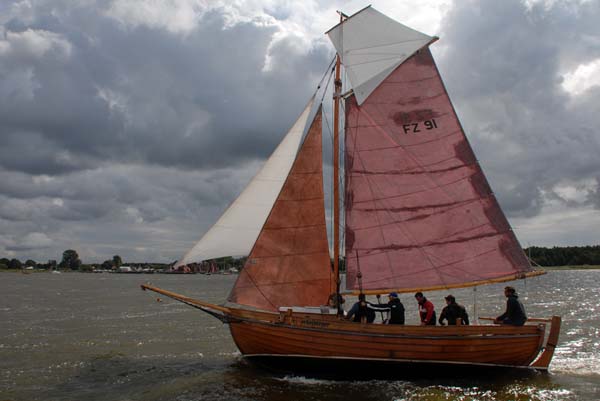Last update:
Zeesenboot regatta Bodstedt
The regatta for Zeesenboots in Bodstedt, which is always held on the first weekend in September, is the oldest and, based on the number of participating Zeesenboots, the largest of the recently regular races for this boat type. In 1965, the Zeesenboot specialist and shipyard owner Eckkehard Rammin took the initiative to persuade the last remaining fishermen which were using these boats in the region to participate in the first regatta of this series. At that time 8 boats are said to have participated. Today there are about 50 boats with their crews that meet in the small port of Bodstedt on the Saaler Bodden this weekend.
Zeesenboots are former fishing boats, based in the southern Baltic Sea, and a piece of maritime culture in this region of Germany. Culture, handicrafts and fishing traditions can be experienced at every regatta in the harbour too. On the regatta weekend there are for sure thousands of visitors who come to Bodstedt to experience the brown sails of the Zeesenboots in the wind.
The race begins in the port when the boats are rigged and sail in the order of the results from the previous year from the berth directly to the starting line immediately in front of the port entrance. Boat by boat then leaves the harbor like a string of pearls. A triangular course is sailed, with the Zeesenboots being classified in two classes depending on their size. It requires a high level of concentration on the start and finish ship in order to correctly recognize all boats and correctly record the sailing times, because the distances between the fastest Zeesenboots are only in the range of seconds.
The Zeesbootregatta Bodstedt is organized by the association Traditionshafen Bodstedt e.V.. The race is part of a series of regattas that start from different ports in the region every year.
Zeesboot, Zeesenboot, Zeese
Which definitions for the terms are correct?
In a short treatise the well-known expert for Zeesenboots Hermann Winkler has examined the origin of the term "Zeese" which gave this boat type the name.
It is assumed that the word "Seyze", already probably used in testimonials of Buggenhagen near Lassan in Western Pomerania in 1315, comes from the eastern Baltic area.
With the east Russian term "sědia", Estonian "sääs" or Lithuanian "sedžia" a weir as well as a pulling net was called at first. Along the southern
Baltic Sea the term gained acceptance for the expression of a catching bag for different kinds of the trawl net fishing.
So the term "Zeese" describes a catching device for fish. Later those expressions like "Zesekahn" (1449 in the Stralsund's chronicle), "Zeszekan"
1524 in a reference to the regulation of the fishery with the Zeese by duke Bogislaw X. and the confirmation about privileges for the town Ueckermünde), "Zesekan"
(1541 in the lagoon regulations of Stettin), "nathe Czesekane" (1601 in the Stralsundische Vischer-Rulle) and finally "Zeesboot" (1858, first memorandum
in the records of Stralsund) were used for boats using these catching devices for fishing. Today and in High German we call these boats "Zeesenboot".
With the extension of the distribution area of this boat type on parts of the Danish coast the term "Åledrivkvase" is used here too.
How the boattype Zeesenboot has developed?
The emergence area of the Zeesenboots is the southern Baltic Sea coastline, the Oderhaff (mouth of the river Oder) and coasts of Mecklenburg and western Pomerania.
Fishermen used the so-called "Zeeskahn" for fishing here in the 16th and 17th century.
The central Pomeranian Zeeskahn of the Oderhaff was an about 20-22 m long boat with two masts which were fitted with solid lugger sails and a foresail sail.
It had two side boards and was still used for fishing in the Oderhaff by the beginning of the 20th century. The Zeeskahn has influenced the development of the
Zeesenboot very much and one assumes today, that the a little smaller western Pomeranian Zeeskahn was a predecessor of the boat type known as Zeesenboot today.
The centres of the fishery with Zeesenboots was the Stettiner Haff (Bay of Stettin, Oderhaff) and later Stralsund before the island Rügen. Starting from here the boat type
and kind of fishing spread across the Mecklenburg-Pommeranian coast down to the Mecklenburger Bucht (Mecklenburg Bay) and later to Schleswig-Holstein.
The development of the Zeesenboots got impulses by the approximately contemporaneous introduction of another boat type, the covered cutters, and the trawl net fishing
on the Baltic Sea. The fishermen, who were trained and employed on big ships in their youth, also got suggestions by the shipbuilding of bigger ships. Furthermore legal
regulations had influence on the development of this boat type. For instance in 1856 some regulations about the authorised sizes of Zeeskahns were given by the town council of Stralsund.
Zeesenboots, as we know them today, were used since around the middle of the 19th century. Unlike the Zeeskahn, the Zeesenboot is a partially covered boat with a gaff rig.
In western Pomerania the rigging similar to a ketch was common, whereas in the Mecklenburg region boats with a rigging similar to sloops were primarily used. A typical
feature of Zeesenboots are the so-called drift beams which were driven in addition to the tail beam and jib beam on the tail and bow and which could keep the Zeese
just as wide open as it was the case at the bigger Zeeskahn. The smaller Zeesenboots were handier, lightweighter and with a lower depth more suitable for the flat
bay waters. They could be handled with a lower number of crew.
Since about 1880 the up to this time usual side boards were replaced by the middle drop keel. Since 1930 the first Zeesenboots were equipped with auxiliary engines too.
However, this had no effects on the fishing methods, but on the opening up of new fishing areas and improvement for navigation in narrow fairways. Furthermore it was
fished under sails since the fishing with the Zeese with engine power in most cases was legally forbidden in the bay waters.
In addition, regulations had effects on the distribution of this boat type. So many fishermen have emigrated with their boats to the Salzhaff region near Wismar and Rerik,
but also primarily to Denmark caused by legal limitations in the last third of the 19th century. From 1880 a numerus clausus limited the number of admittances for fishing
with the Zeese in the area of Stralsund. Since 1908 it has been forbidden to fish with the Zeese at all in the Oderhaff. There have been corresponding delimitations already
before this time in other areas too.
Zeesenboots were used for the fishing in Germany until the 1960s. The decline started already after the World War II. The changed production conditions in Eastern Germany
after 1945, the development of other fishing methods, e.g. the fishing with bigger fish traps, extended or other fishing areas, that bound fishermen somewhere else and
continuous water deterioration in the lagoons which led go down catching yields have been the main causes of the fall.
Today, a fleet of about 90-100 boats still exists, which are used as sport boats, leisure yachts and for the care of traditions. The oldest Zeesenboots still in existence
are from the time around 1880. Many of the boats are maintained with high expertise and rebuilt in the tradition of the Mecklenburg-Pomeranian fishery Zeesenboots.
Where are sailing areas for Zeesenboots?
The most important ports in which Zeesenboots are still based today include Bodstedt, Wustrow, Barth, Wiek, Althagen, Ribnitz and Damgarten, Freest, Stralsund, Greifswald and Rostock.
What dimensions and designs are typical for Zeesenboots?
The Zeesenboots have common design features based on the fishing technique. Basically, however, every boat is an unmistakable original, not so much because of the rig, but mainly because of the hull and its superstructure. There has never been series production. You can differentiate the Zeesenboots in the shape and form of the outer skin, the fore and aft as well as the internal structure. The external dimensions are also quite different. The average dimensions are summarized in the table.
| Length over all: | 10 - 12.50 m |
| Breadth: | 2.80 - 3.45 m |
| Depth: | 0.95 – 1.20 m |
| Height of the main mast: | 10 – 11 m |
| Height of the mizzen mast: | 6 – 7 m |
| Sailing area: | 70 – 110 m² |
Zeesenboots are flat-bottom ships without a keel. This hull shape enables drifting before the wind. In order to be able to sail close to the wind, first side boards and later
middle drop keels were used.
The hull is mostly half-covered and was made of oak in clinker or later in kraweel construction. The thickness of the planks is about 4 cm. Stem and stern shapes are variable.
Older boats have a convex stern and a pointed stern with a straight stern. Since around 1870 Zeesenboots have hull shapes that were used in large shipbuilding at the time,
for example concave clipper stems and a round stern.
The masts, beams and superstructures were made of softwood.
Another special design feature is the water-flooded fish room, in which the caught fish could be transported alive.
Where were Zeesboots built?
The most important historical boatyards where Zeesenboots were built are Carl and Hans Domquast in Fuhlendorf, Johannes Holzerland in Barth (today Schiffswerft Barth), Christian Jarling in Freest, the Poeler Bootsbau GmbH in Kirchdorf on the island Poel, Stellmacherei Lange in Stove near Wismar, Hermann Grählert in Pruchten, the Thomzik–Werft in Stralsund and Ekkehard Rammin&Söhne in Barth.
What rigging and sailing characteristics do Zeesenboots have?
The rig of the Zeesenboots remained unchanged over a relatively long time period. Zeesenboots either are rigged similar to sloops with 4 sails or to ketches with 5 sails.
The sloop-like rigging was dominant along the coastlines of Mecklenburg whereas the ketch-like rigging was typical for boats from Stralsund, Rügen or the Oderhaff.
The sails were made of linen and later of cotton which were blazed with pig fat and herring brine with pine tar, beef dripping or horse grease, flax oil and ochre earth
every two years. Besides a corresponding impregnating effect this treatment yielded the typically brown colour of the sails.
Zeesenboots belong to the best sailing boats in the Bodden area. They reached speeds up to 7 sea miles per hour and against the wind one can sail up to 7 points to the wind (about 80°).
How was fished with a Zeesenboot?
Zeesenboots were used in the fishery. The fishing with the Zeese is a simple kind of trawl net fishing. A net, the so-called Zeese, which gave the ship type the name, is dragged over the ground of the water. In that process the net is kept open by spreading with beams on fore and aft of the boat.
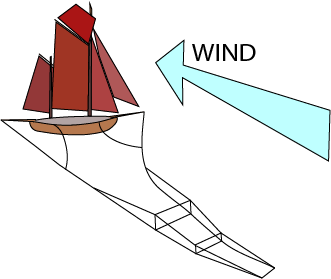
Drifting with the Zeese
The boat lies across the direction of travel. It's drifting. With appropriate sail positions you can sail more or less close to the wind, take evasive maneuvers
in case of obstacles in or on the water, or follow a bottom profile of the water bed. The size of the sail area is determined according to the strength of the wind.
The success with fishing rather depends on the exact knowledge of the water bed.
The crew of a Zeesenboot usually consisted of a fisherman and an assistant who shared all the work that came up. Because of a better income it was fished in most cases by night.
References
Hermann Winkler:
"Zeesboote, Fischsegler zwischen Strom und Haff",
Hinstorff Verlag, Rostock, 2. Auflage, 1990, ISBN: 3-356-00362-3
Comprehensive reference work on Zeesenboots with extensive partly historical images, descriptions of the historical development of the boat type and fishing
Hermann Winkler:
"Zeese, Zeesboot oder Zeesenboot und Fischerzeese",
in "Alte Schiffe", Kiel, 12/1994
Short treatise on the origin of the terms
Timm Stütz:
"Erlebniswelt Zeesenboote",
BusseSeewald DSV Verlag, Hamburg, 1997, ISBN: 3-88412-247-9
Illustrated book with numerous large-format photographs, a portrait of the fisherman Ewald Moritz, the Jarling shipyard in Freest, the new construction of the Zeesenboot FZ42 "Sunddriewer", Zeesenboots as model
A. Dietzel, E. Krohn, R. Legrand:
"Zeesenboote im Nationalpark",
Sausewind Verlag, Ribnitz – Damgarten, 1994, ISBN: 3-9803999-0-7
Boat register with main data and photos of the Zeesenboots still in existence
Jochen von Fircks:
"Ewer, Zeesenboot und andere ältere Fischereifahrzeuge",
Hinstorff Verlag Rostock, 1982
Historical basics with sections on the development of fishing in cities and villages, about fishing with Zeesenboots, the development of this boat type and a model building plan
Wolfgang Rudolph:
"Segelboote der deutschen Ostseeküste",
Akademie-Verlag, Berlin, 1969
Ethnographic inventory of sailing vessels on the German Baltic Sea coast, contains chapters on Zeesenboots with sections on boat designation, boat building and boat shapes, rigging and sailing characteristics, work and life on board and sailing areas
Hermann Winkler:
"Zeesboote. Segler durch die Zeiten",
Hinstorff Verlag, Rostock, 1. Auflage, 2007, ISBN: 978-3-356-01187-6
Extensively illustrated summary presentation of the Zeesenboot community, the fishing and maintenance of traditions

